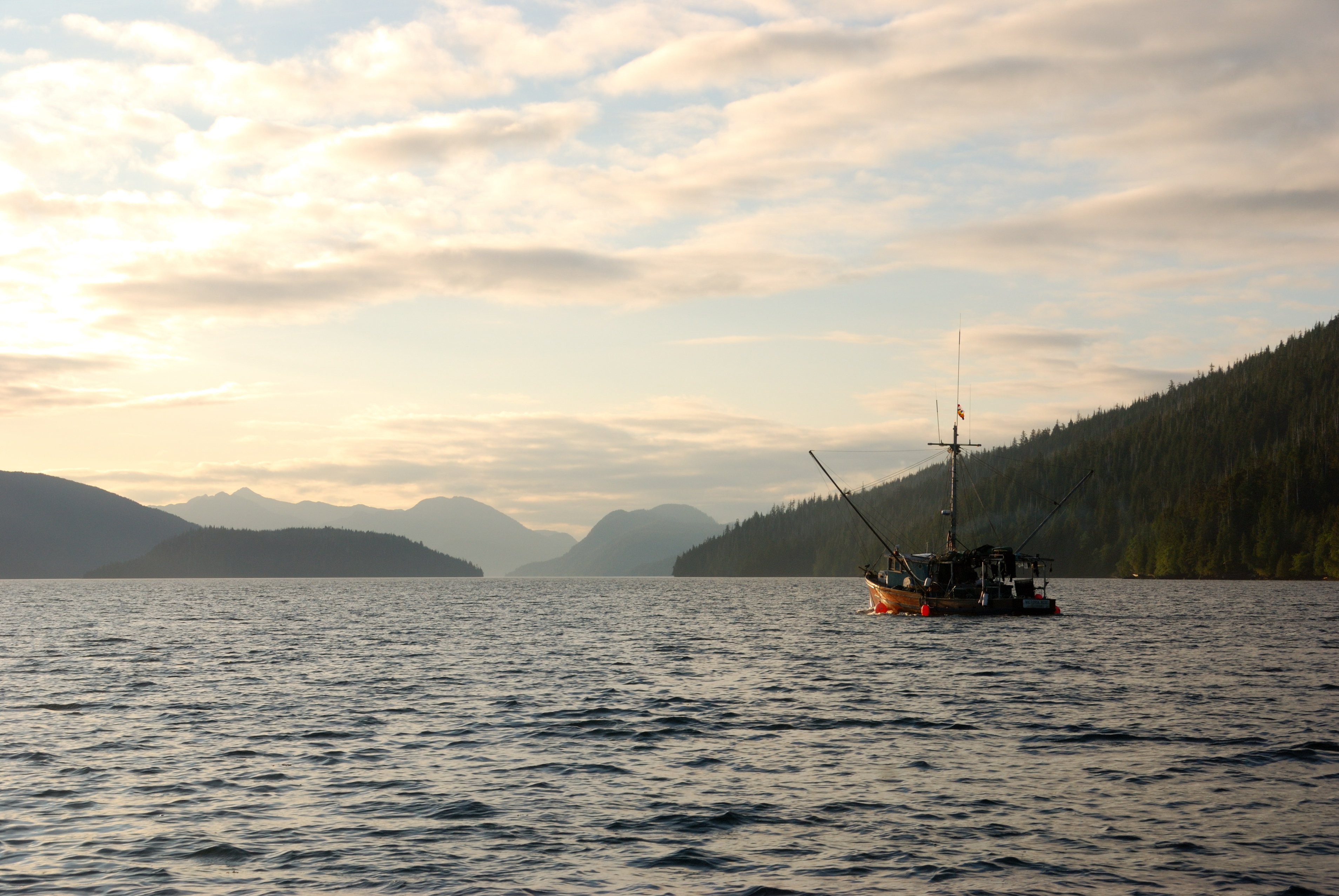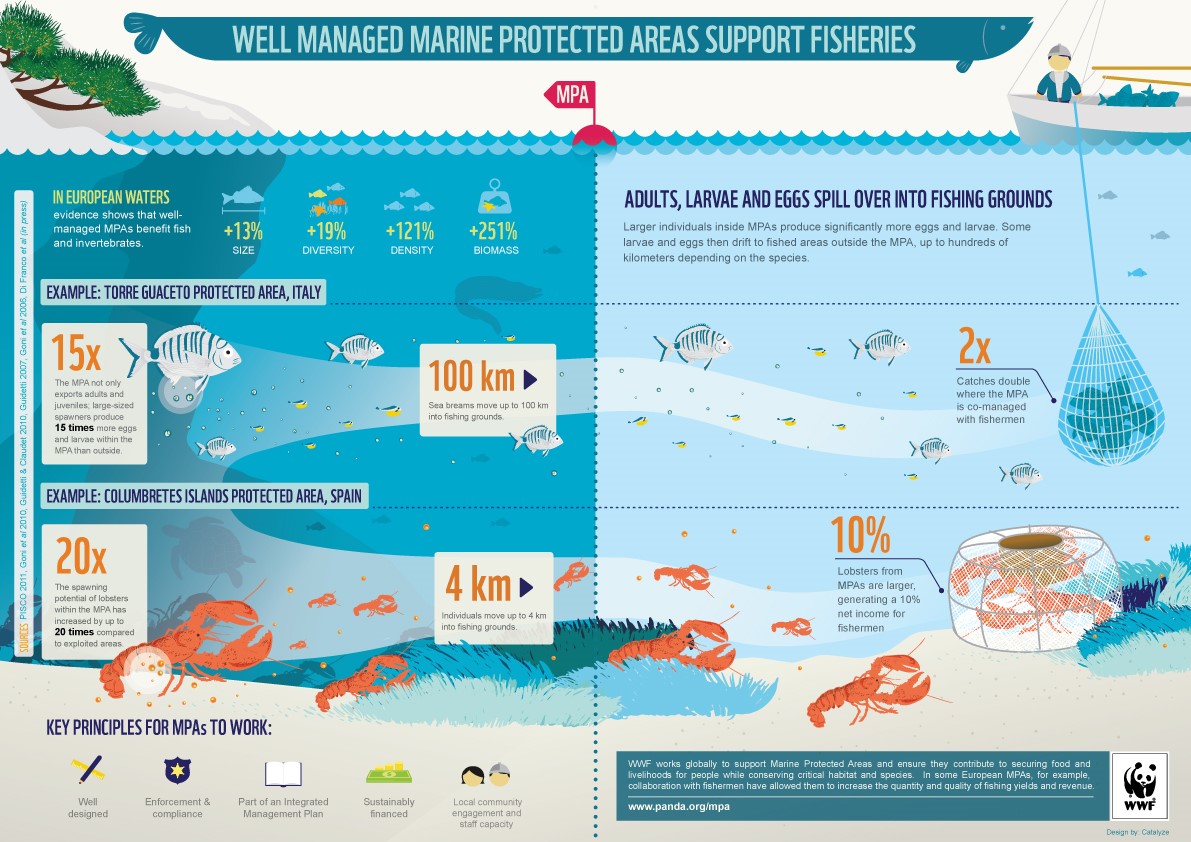
Coastal communities in BC have always relied on the ocean – for food, culture, recreation and livelihoods. Unfortunately, many of those coastal livelihoods have been suffering for years due to collapsing fish stocks, driven by overharvesting, habitat destruction and climate change. The fishing sector’s struggles have been exacerbated by global supply chain disruptions and worker shortages caused by the COVID-19 pandemic, and the coastal tourism industry also took a huge hit from the steep decline in travelers.
Rebuilding a healthy economy on the coast means ensuring healthy oceans and the sustainable use of resources – and marine protected areas (MPAs) should be part of the solution.
BC’s blue economy
The “blue economy” (all economic sectors that have a direct or indirect link to oceans, seas, and coasts) includes established ocean industries like fisheries, tourism and shipping, along with new and emerging activities like renewable energy development. According to a recent analysis by the Province of BC,1 ocean economies add around $21.5 billion annually (8% of BC’s total GDP) and provide 131,000 direct jobs (4.9% of jobs in the province). The largest sectors of BC’s blue economy are transportation ($5.9 billion), tourism and recreation ($5.8 billion), forestry ($4.9 billion), and seafood ($1.5 billion). The fastest growing sectors are transportation and tourism/recreation.
However, the ability of these industries to benefit coastal communities depends on the health of the coast and ocean, which are under threat from overexploitation, pollution, climate change and coastal development. Growing the ocean economy requires a commitment to ocean protection, and real action to ensure a resilient, sustainable and equitable ocean future.
Canadians recognize that unhealthy oceans are unable to support economic growth. A recent report released by Fisheries and Oceans Canada (DFO) on its Blue Economy Strategy consultations, which engaged Canadians from coast to coast to coast, notes the recurring theme that oceans and marine resources must be healthy to support a prosperous blue economy:
Above all, we heard that our oceans and marine resources must be healthy to be able to support a blue economy. To achieve this objective, it was recommended that we value the natural environment by taking action to protect, conserve, restore and rebuild our marine and coastal resources—and then maintain healthy oceans to ensure sustainable growth.
– DFO, What we Heard Report (March 2021), at p. 8
How marine protected areas can help
What are MPAs?
Marine protected areas (MPAs) are areas of the ocean that are legally protected and managed to conserve nature and associated ecosystem services. MPAs are recognized as one of the most effective tools to protect ocean health and sustain marine resources.
Like parks and protected areas on land, MPAs come in many forms. They can vary in size, the types of human activities permitted, and the means in which they are designated and managed. MPAs do not always mean that all activities are prohibited, or that humans must stay away. In many cases, sustainable resource use is compatible with, and can even contribute to, the objectives of marine protection.
While the primary function of MPAs is generally to deliver conservation benefits (like preserving sensitive habitats or saving endangered species), MPAs can provide direct and indirect benefits to people by safeguarding ecosystem services produced by healthy oceans. These go hand-in-hand.
Studies that have investigated the effects of MPAs show that they can be beneficial to the blue economy, particularly for fisheries and tourism. These sectors depend heavily on healthy ecosystems, though their operations are not always sustainable.
Commercial fisheries require healthy fish stocks, but they often engage in overharvesting and destructive practices that deplete stocks, destroy fish habitats and endanger the longevity of fisheries. Similarly, tourism operations benefit greatly from well-preserved ecosystems that bring in visitors, while excessive exploitation may have negative consequences on ecosystems and sustainable development. MPAs can help support these industries by preserving or restoring the ocean resources they depend on.
MPA benefits to fisheries
Fisheries are the backbone of many coastal communities and are vital to First Nations’ communities, culture, well-being and way of life. Despite their importance, many fisheries in BC are edging closer to collapse, in part due to inadequacies of contemporary management systems. Establishing MPAs can help rebuild and sustain viable fisheries, especially when combined with better fisheries management practices (e.g., Indigenous fishing systems).
MPAs reduce or eliminate fishing pressure within their borders, providing a refuge where fish can grow larger, live longer and produce more offspring. When well managed, MPAs can quadruple fish populations in only a decade and increase the abundance, body size and reproductive output of commercially-targeted species.
In addition to supporting stock recovery, MPAs can benefit fisheries beyond their boundaries via the “spillover effect.” This occurs when adult or juvenile fish move from protected areas into neighbouring fishable waters. Various studies have documented fisheries benefits linked to the spillover effect of MPAs in the form of increased revenues, greater yields and reduced effort-related costs.
Source, “INFOGRAPHIC: How well managed marine protected areas support fisheries in temperate areas” (published April 22, 2015), WWF 2015.
MPA-driven benefits for fisheries can significantly outweigh the initial costs to impacted fisheries (i.e., foregone fishing opportunities from setting aside areas for conservation). A study in Spain documented a mean annual net gain of 10% of lobster catch in adjacent areas surrounding an MPA. Another lobster study in California found that a 35% reduction in fishing area resulting from MPA implementation was compensated for by a 225% increase in total catch after only six years.
The benefits for fisheries can be maximized, and costs minimized, when MPAs are well planned, strongly enforced, and developed with adequate and equitable stakeholder engagement.
MPA benefits to tourism
Coastal and maritime tourism is one of the fastest-growing sectors in the world, and British Columbia is no exception. For this sector to continue to grow and succeed, coastal and marine ecosystems must be well preserved to maintain their natural beauty and allow wildlife to flourish, which brings in tourists.
Through conserving nature, MPAs have been proven to increase the number of visitors and tourism ventures, as well as the revenues generated by nature-based tourism and recreation. The establishment of MPAs may also have knock-on effects that are beneficial to local businesses and services onshore (e.g., shops, carparks, camping facilities, hotels).
On the flip side, tourism-related activities and services can produce major benefits for conservation when carried out in a sustainable manner. For example, sustainable tourism can generate funds for MPAs and conservation projects (through visitor fees and corporate donations, for example), raise public awareness about the values of healthy marine ecosystems, and provide an alternative option to unsustainable industries that damage marine resources.
Other economic benefits of MPAs
MPAs can provide a broad range of other direct or indirect market benefits. In terms of direct job creation, MPAs create demand for administration, conservation, management, monitoring, and research jobs. For example, the Gwaii Haanas National Park Reserve and Haida Heritage Site has 40-69 people on staff depending on the time of year, including full-time, part-time, seasonal staff and summer students.
Indirect economic benefits linked to MPAs stem from marine ecosystem services. For example, MPAs can protect coastal habitats that reduce human vulnerability to climate change impacts (coastal ecosystems act as natural barriers to storm surges, flooding, and erosion), as well as public or private expenditure on responses to natural disasters. Other notable services produced by marine and coastal ecosystems include carbon sequestration and storage, wastewater treatment, compounds for fighting disease, and recreational, aesthetic and spiritual values.
MPAs are well worth the investment
It is important to acknowledge that any market benefits resulting from MPAs need to be set against potential costs incurred from their establishment, along with management, monitoring and enforcement costs. That said, research shows that the return on investment can be very high.
One comprehensive study found that the benefits of expanding the global coverage of MPAs (to achieve international targets calling to protect 10% to 30% of marine areas) will exceed costs by a factor of 1.4 to 2.7. Another study calculated that protection of 30% of the ocean in effective MPAs could recover ocean health within 30 years, with an economic return of $10 for every $1 dollar invested and the creation of tens of thousands of jobs.
Canada’s commitments to MPAs and the blue economy
Canada has committed to sustainably manage 100% of its national waters by 2025 and to conserve at least 30% of its marine and coastal areas by 2030. The Government of Canada also has a new goal, which is to develop a Blue Economy Strategy to build a more sustainable ocean economy, while advancing Canada’s conservation commitments.
A Blue Economy Strategy must prioritize ocean protection – like completing the MPA network currently under development in the Great Bear Sea. Doing so will create good jobs and deliver positive, long-term economic benefits to coastal communities – now and into the future.
1 BC government presentation at an Information Session for Stakeholders of the BC Coastal Strategy process March 29 and 31, 2022 (presentation dated Mar 25, 2022; Version 1.0. Note: This presentation may undergo minor edits; it should not be considered the final version). Scheduled to be released publicly.
Top photo: Rowan Trebilco/Green Fire Productions
This is the 4th blog in a series about the benefits of marine protected areas.
Part 1: Climate change was front and centre this summer: let’s focus on ocean protection this fall
Part 2: Will big marine protection commitments at COP26 inspire Canada?
Part 3: Marine protected areas are an “insurance policy” in turbulent times
Part 4: Marine protected areas are central to our blue economy
Part 5: How protecting the ocean helps humans in return
Part 6: How better ocean management can promote food security
